Posted by
JCC Fitness Team on May 16, 2024
The Role of Powerlifting in Personal Training
Eli Snyder, JCC Personal Trainer
What’s an efficient way to get stronger, move more easily and feel better?
Eli Snyder, JCC Personal Trainer, likes the three lifts that are the basis of the strength sport called Powerlifting: Squat, Bench Press and Deadlift.
“I like them for myself because they get me jacked,” he laughs. Of course Snyder, who has competed in Powerlifting and can squat 500 lbs., doesn’t expect that building a brawny physique is everyone’s goal, but he does see the value of incorporating Powerlifting into clients’ personal training sessions. And Powerlifting workouts can focus on building a lean and strong body.
-
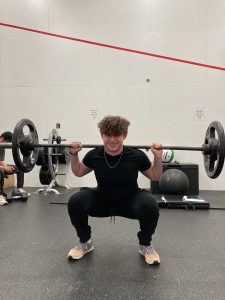
-
SQUAT
-
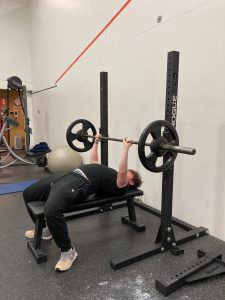
-
BENCH PRESS
-

-
DEADLIFT 1
-
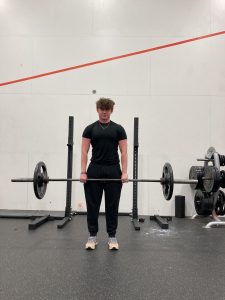
-
DEADLIFT 2
“These exercises use a lot of muscles and build full body strength, which all are helpful in everyday life,” he says. For example, squats build strength that make it easier to get up from a chair.
Snyder notes that “warming up before doing Powerlifting is very important.” He incorporates a warm up before doing Powerlifting exercises, either before a personal training session or for longer sessions, at the beginning of the session.
“Powerlifting is a very efficient and quick workout,” he says. “Hypothetically, if you just do these, you get results.”
A Holistic Approach to Personal Training
Brandon Smith, JCC Personal Trainer
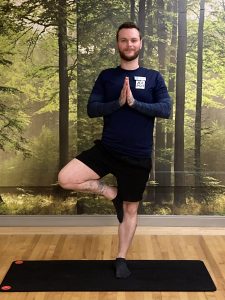
Brandon demonstrates his favorite yoga pose. “Tree Pose strikes a balance between fitness, wellness and restoration,” he says.
Personal Training often is thought of as training focused on building strength, as an athlete might require. But many of us are not athletes in training, or have other needs and goals, and each of us is different in our body types and the issues we have with our wellness and fitness. And even athletes need more than strength training for optimal performance.
What we have in common is that we all want to feel good!
Brandon Jones, JCC Personal Trainer who recently came to Pittsburgh from San Juan Island, Washington, and a native of England, advocates a holistic approach to training “to help you create a holistic, sustainable and effective connection with your mind and body.”
Brandon is certified in Exercise Therapy, which is combines focuses on Strength, Mobility, Flexibility, Rehabilitative Exercises, and Functional Fitness. “The Exercise Therapy approach is wonderful for traditional strength-building goals, but also is very appropriate in addressing chronic injuries or isolated health problems, and age related changes to the body,” he says.
“Exercise Therapy has a more restorative purpose, with the goal of correcting muscle imbalances,” he says. “It’s focused on improving mobility, flexibility and range of motion, and on functional fitness.
Brandon, who has 12 years experience as a trainer, also is I.S.S.A certified as an Elite Personal Trainer, Fitness Coach and Nutritionist. “I like being able to bring all of these services to create a very holistic plan for each client,” he says. “This set of qualifications and skills allows me to work with diverse population of people towards their balance and well-being.”
He is practiced in a form of stretch therapy in which the client is in a passive and relaxed state; often the client “hops off the table and feels the effects immediately, and the results are longer-lasting.”
In addition to athletes and individuals with strength goals, he trains older adults with the focus on quality of life. “I can work with a wide variety of people who need some form of rehabilitative pain or chronic illness management, as well as those recovering from injury or surgery,” he says. “I love being able to help people live life better!”
How to Get Enough Exercise
Laurie Wood, Wellness Director
The challenge is to make sure you’re getting enough exercise to stay healthy and fit.
But for many of us, that’s easier said than done. Despite our best intentions, we often have a hard time getting started and even then, it’s not always easy to keep going.
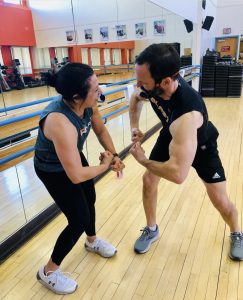
Group Exercise instructors Laurie Wood and Evan Aeillo
“Personal Training is a great way to start a fitness routine,” says Laurie Wood, Wellness Director. “With a Personal Trainer, you’ll be given a fitness assessment and recommendations to reach your goals, and you’ll learn how to use equipment and a variety of exercises.”
But, Laurie says, that’s usually not enough. “To get fit and stay healthy, everyone needs 150 minutes of moderate exercise and two days of strength training each week.”
She adds, “You can’t just do personal training once or twice a week and have that be enough to meet your goals and improve your health.” In other words, one or two Personal Training sessions each week is not enough.
How do you round it out? With Group Exercise, Laurie says. “It’s a great compliment to Personal Training with the added bonus that it increases adherence to your routine. When you have a group that you work out with, you develop friendships and that makes exercise fun.”
At the JCC, the wide variety of group exercise classes promotes healthy routines. “We don’t want any overuse injuries,” Laurie says, “so we want to help people vary their exercises.”
New members receive a free fitness assessment, which can help pinpoint goals and help you understand how you can benefit from Personal Training. And if a member is not sure which Group Exercise class to try first, talk to Laurie or anyone on the Fitness Staff! They’ll help you find what suits your interests and schedule.
Bottom line: To develop a well-rounded healthy fitness routine, work with a Personal Trainer and get in the swing of Group Exercise classes. You’ll love the way you feel!
Training the Knee
Michael Flynn, JCC Personal Trainer
Why focus on the knee?
The main reason is simply that the knee is the body’s largest joint – and it’s important. “We need the knee for pretty much any form of movement, especially movement that is upright – walking, sports, and even sitting,” said JCC Personal Trainer Mike Flynn, a Gray Institute Fellow of Applied Functional Science and expertise in Functional Manual Reaction, Functional Golf Systems and 3D Movement Analysis & Performance Systems.
Flynn said that the traditional approach to training the knee is somewhat 2-dimensional, focusing on a simplistic idea of what the knee does – flexion and extension – so training was done from a seated position with the foot off the ground.
In this traditional approach, with your foot never touching the ground, to raise the leg at the knee you mentally cue the quad muscle, to lower it, you cue the hamstring muscles.
“Actually walking, which of course uses the knee, is very different,” Flynn said. “When we walk, we put a foot on the ground; there’s a little rotation, a little lateral movement, and there’s body weight.”
In walking, the hamstring and quad work as a decelerator – slowing down the knee as you step, and rotation and lateral movements also are involved.
That chain reaction of muscle deceleration with gravity, ground reaction force, mass, and momentum all combine to activate the leg muscles.
“Training for the 3D functionality of the knee allows for better activation of muscles when we walk,” Flynn said.
Take it a step further – and you can recognize that the ankle and hip also are involved, to the point that some might call the knee “the foot-hip joint,” Flynn said, “because it’s so heavily influenced by the foot and hip joints.”
“That’s a lot of words to say that we want all the joints and muscles to work together.”
Here are four exercises that apply this idea to train the knee more functionally:
Note: As a warmup, Mike suggests repeating each 5 times per side. For strength-building, you can add weights and increase repetitions.
To modify for stability, you can put one hand on a wall or bar.
- Side Lunge
- Start standing upright
- Step one leg out to the side
For more glute involvement, push your hips back.
For more hip flexor involvement, push your hips forward
- Bring it back
- Side Balance
- Start in single leg toe touch position
- Reach out the toed foot while allowing your grounded knee to bend
- Return to your starting position.
- Rotation Lunge
- Start standing upright.
- Step out at 45 degrees.
For more glute involvement, push your hips back.
For more hip flexor involvement, push your hips forward
- Return to your starting position
4. Rotation Balance
- Start in single leg toe touch position
- Reach out the toed foot at 45 degrees while allowing your grounded knee to bend
- Return to your starting position.
Who Should Do Training for Gait and Balance?
(Spoiler alert – almost everyone!)
Elaine Cappucci, Fitness Director JCC South Hills
Once you’ve learned how to walk and balance on one or both feet, walking and balance mostly just happen without you having to think about how to move your body, your brain has been trained. While going about your average day, you may not think about gait and balance, but you need them both to do just about everything including walking, playing a sport, getting out of a chair, or leaning over to tie your shoes.
Your balance affects your gait and your gait affects your balance. When balance is off, it is difficult to make the feet and legs move and work as they should. If you can’t walk correctly and with proper posture – standing upright and pushing off through the foot and lifting one foot to move it forward – your chances of tripping and falling are significantly increased.
Walking in everyday life is harder than it looks. And it is not just a physical activity, it is also a cognitive activity. So, to train one’s gait and balance, we must work on muscle strength and range of motion along with the cognitive skills of decision making, adaptation, dual tasking and obstacle negotiation. With illness, injury, muscle weakness or imbalances, orthopedic issues, and age, our gait and balance can deteriorate. Walking becomes more complex in areas with changes in terrain, flooring or elevation, or with noise, a chatty friend or perhaps cars coming and going,
Gait and balance typically start declining in mid-life, sometime after age 40.
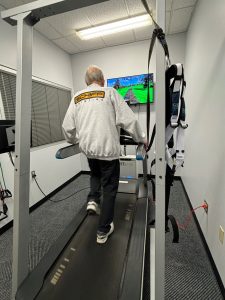
The Gait Better program uses a treadmill and virtual reality scenarios to help members improve their gait, balance, and cognitive motor skills.
According to studies done at the Cleveland Clinic, around 15% of people experience a gait abnormality by age 60 and more than 80% of people over age 85 have a gait abnormality.
Personal trainers have a variety of ways to train gait and balance. For balance, in the gym we mostly use single-tasking exercises like balancing on Bosu balls or balance pads that work to train the muscles of your lower limbs. For gait, we may again use single-task exercises like working on walking patterns, making sure clients are pushing off with their foot and landing heel to toe (not shuffling). We can improve both gait and balance by working on strength in the legs, feet, and hips through strength training.
But, since neither gait nor balance are single-function tasks, our clients should have multi-task and cognitive training as well. Our South Hills Gait Better system incorporates a treadmill and virtual reality screen to achieve motor-cognitive training for both your body and your brain. By completing tasks like walking over virtual hurdles and puddles and spotting signs and animals along the path, your Gait Better trainer is helping you create new neural pathways and retraining your brain. Consider it strength training for your brain. The formation of new neural connections eventually makes your brain more efficient and more capable of handling real-world situations that include the need for balance and a good gait.
So yes, gait and balance training can be beneficial for almost everyone.
Here are a couple of exercises you can try on your own:
-
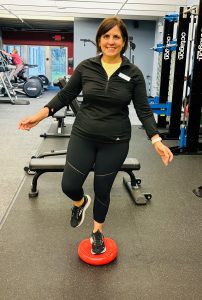
-
Balance pads or Bosu balls are a good option for training static balance and well as strengthening the many small muscles of your foot and ankle that are essential in both balance and gait.
-
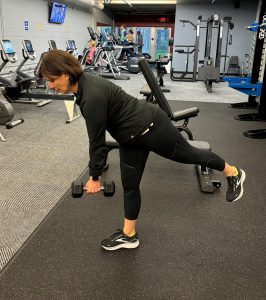
-
A single leg Romanian deadlifts is a great multi-task functional exercise that incorporates movement, strength training and balance.
Strengthen Your Lower Body
Alida Wright, JCC Personal Trainer and HIIT and Water Aerobics Instructor
Squats and lunges are exercises that most everyone has heard of, for good reason – these simple moves can help strengthen your lower body and have many benefits. “A strong lower body contributes to a healthy heart and increases bone mineral density,” says Alida Wright, JCC Personal Trainer and HIIT and water aerobics instructor.
There are more benefits: “Lunges and squats can help not only build muscles in the lower body, but these exercises also recruit core and oblique muscles, as well as improve posture, balance and flexibility,” Alida says.
“Building muscles in legs can help prevent injuries in the hips, ankles and knees. Being able to do squats helps everyday motions like sitting down, standing up, and lifting things off the ground.”
How to do basic squats and lunges:
TRADITIONAL SQUATS focus on quads
- Stand with your feet shoulder distance apart
- Maintain strong posture and tight core
- Send your hips back first and let your knees follow as you come down as deeply as you can, while keeping your heels on the ground.
- Arms can be in front of you or on your hips. If you are using weights – hold a weight in front of your chest or for dumbbells, each arm holds a dumbbell on each shoulder.
SUMO SQUATS focus on quads and incorporate the adductor muscles (inner thighs)
- Take a wide stance and turn out your feet about 45 degrees – your knees should be in line with the direction of your toes.
- Proceed as the Traditional Squat (above).
LUNGE
- Stand, maintaining a strong upright posture. Arms can be on your waist or in front of you, parallel to the floor.
- Take a big step forward.
- Bend your back knee towards the floor and your front knee; the goal is 90 degrees for each leg.
- Step up, bringing the back leg to meet the front.
- Repeat with the other leg leading.
Try Boxing!
Christine Ulrich, JCC Personal Trainer and Bronze Level Boxing Coach with USA Boxing
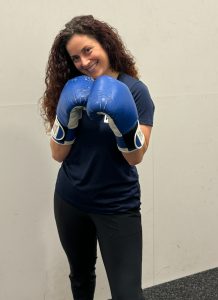 Want to get a good workout? Try Boxing!
Want to get a good workout? Try Boxing!
Boxing, a combat sport that has been practiced since before the time of ancient Greece, has been used to train people for performance in the art of striking, as well as general physical conditioning. Recently, it has become more popular as a form of exercise.
Why Boxing? “Whether your goals are to get stronger, improve cardiovascular endurance, or improve coordination and balance, boxing can help, says Christine Ulrich, a JCC Personal Trainer and Bronze Level Boxing Coach with USA Boxing who incorporates boxing moves into her training as well as into her HIIT classes.
“My passion is to help people build inner and outer strength through physical fitness,” she says. “I love incorporating boxing into my training both for fitness as well as skills training and technique. It is also great for stress management!
Christine shared some of the Benefits of Boxing:
- Improves mental alertness and focus
- Improves stress level and mood and has a positive impact on mental health
- Burns more calories – boxing is proven to burn more calories than traditional cardio workouts
- Improves coordination and balance
- Incorporates total body strength and improves cardio endurance
- Improves sleep quality
- It’s fun! Working out should be fun and boxing is a fun way to get fit!
Dynamic Warmup
Molly Rubenstein, Certified Personal Trainer and JCC Group Exercise Instructor
What’s the best way to prepare your body for a workout?
“It used to be that we would always recommend static stretches – stretches that you hold in one position,” says Molly Rubenstein, Certified Personal Trainer and JCC Group Exercise Instructor.
Research now shows that the best way to prepare for a workout is through what is called a dynamic warmup or dynamic stretching — using active movements to prepare muscles for exercise.
Molly suggests spending 5-10 minutes doing dynamic stretches before you work out “to get your blood flowing, to get the conversation started between your brain and your muscles.”
Here are four movements for a Dynamic Warmup:
1) Walking Lunges stretch the glutes, chest, and obliques. Walk forward by lunging out with one leg, then the other, repeating on alternating sides


2) Hip Cradles open up the hips and lower body muscles. Stand tall and lift up one knee; externally rotate that leg so your inner thigh is pointing up. With both hands, grab the leg and cradle it higher to stretch out the glutes. Slowly lower to repeat on the opposite side to continue moving forward.
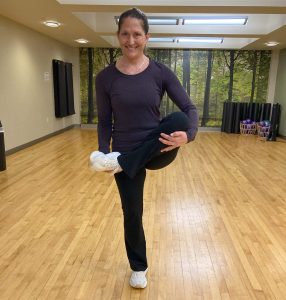
3) Lateral Shuffle, which fires up the muscles in your calves, hamstrings, quads, hip flexors and glutes, increases coordination and agility. On bent knees, shuffle from side-to-side across the room a couple of times.

4) Supine Twist stretches the glutes, chest, and obliques. Lying on the floor, stretch arms into a T, and let the knees drop to one side. Look towards the other side. Hold for 10 seconds and move knees to the other side.
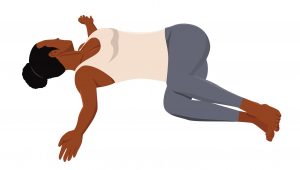
The Benefits of Pilates
Annie Kostovny, JCC Fitness and Wellness Coordinator and Personal Trainer
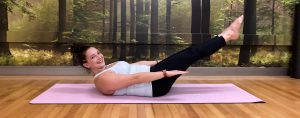
Overheard in the JCC locker room:
“Pilates really helps my back pain.”
“Pilates makes me sweat. That’s how I know that it’s working.”
Pilates is an exercise method that uses low-impact movements in a slow and controlled way. The exercises can build muscle and strengthen the core.
“I fell in love with Pilates the first time I did it,” says Annie Kostovny, JCC Fitness and Wellness Coordinator and Personal Trainer, who subsequently trained to teach Pilates.
“Pilates is accessible to everyone, because the movements can all be modified,” she says. “When you take a class, you’ll leave feeling taller and stronger.”
Here are just some of the reasons why Pilates is so beneficial:
- Increases core strength (stomach, hips, back, and glutes)
- Decreases back pain (due to stronger and more stable muscles in the stomach, back and hips)
- Improves mobility and flexibility- during Pilates you do exercises that will lengthen and stretch your muscles
- Decreases stress and improves sleep (any form of exercise will do this)
- Reduces your risk of injury
“Pilates complements your personal training because it helps you gain mobility, build a strong core, and gain body awareness,” she says.
The JCC currently offers Pilates mat classes in the Recovery Room at the JCC Squirrel Hill. Sign up on the JCCPGH app.
Why Mobility Matters
Fabiola Perrone, JCC Personal Trainer
 While most of us relate being “fit” or “in shape” to being strong, strength doesn’t stand alone. You need good mobility.
While most of us relate being “fit” or “in shape” to being strong, strength doesn’t stand alone. You need good mobility.
What is mobility? It is the ability to take a specific muscle through the full range of motion, enabling you to move with control and stability.
“It’s being able to own your body,” says Fabiola Perrone, JCC Personal Trainer. “It’s about growing the possibilities of being able to get into a pose.”
Mobility isn’t necessarily going to give you a six-pack or sculpted upper arms, but improving mobility will help you feel and carry yourself better.
Muscles are compact and as one builds muscles, they tend to get tight and can constrict range of motion. Focusing on mobility as part of a workout will help build a base on which you can develop your power and strength.
“Bone density and muscle mass decrease with age,” Fabiola says. “The core of my approach is for bodies that will be functional to us throughout our aging; to build a body that can move through deeper ranges of motion.”
That translates to movements such as walking – how high you can lift your legs to take a step, and even sitting – developing the mobility for control as you sit back into a chair.
One important set of metrics that Fabiola uses to assess each personal training client is to determine their ranges of motion for specific joints – the problematic areas from shoulders to hips, knees and ankles.
Here are some simple exercises to help develop mobility in these areas.
Hips: 90/90 Stretch:
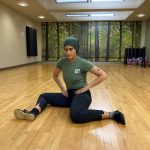
- Sit on the floor and bend one leg in front of your body with your hip rotated out. Position it so your lower leg and knee are resting on the ground. Your leg should form a 90-degree angle, and your ankle should be neutral so your foot is pointing straight.
- Position your other leg beside you with your hip rotated inward and your shin and ankle on the ground. Bend your knee so your leg forms a 90-degree angle. Your back knee should be in line with your hip, and your ankle should be neutral.
- Try to keep your back straight and resist the urge to bend to one side. Think about sitting into both hips equally and easing the lifted hip straight down toward the ground.
Knees & Ankles: Knees Over Toes
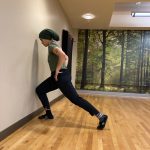
- This may be best done near a wall.
- Start by lunging forwards while allowing your knee to past your toes as far as you comfortably can. Do not allow the front heel to lift off of the floor during this phase.
- Once maximum knee flexion is reached, drive through the heel to push the body backwards to standing position.
Shoulders: Wall Circles
- Stand perpendicular to a wall.
- With your arm straight and palm facing away from the wall, slowly begin to draw a big imaginary circle with your hand.
- After your hand has reached 12 o’clock, you will need to shift your palm to face the wall.
- Go as far as you comfortably can, and reverse movement to come back to where you started.
Ankles: Squats
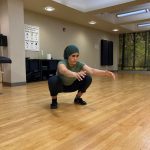
- Stand with feet a little wider than hip width, toes facing front.
- Drive your hips back—bending at the knees and ankles and pressing your knees slightly open—as you…
- Sit into a squat position while still keeping your heels and toes on the ground, chest up and shoulders back.
What to expect from your assessment
Bill Herman, JCC Fitness Sales Coordinator
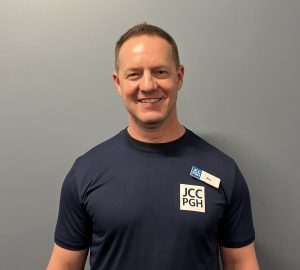 When we say that the JCC is for every body, we mean it. At the JCC, we never stop striving to provide fitness and wellness programs appropriate to each individual’s interest and need.
When we say that the JCC is for every body, we mean it. At the JCC, we never stop striving to provide fitness and wellness programs appropriate to each individual’s interest and need.
JCC Personal Training is especially suited to every body, whether it’s an athlete training for competition, a teen learning life-long healthy habits, an individual who’s trying to banish their love handles, or an older adult who wants to stay mobile and independent.
In fact, the JCC takes its mission so seriously that every new member is offered a free fitness assessment. “We want to personally acquaint you with our personal training program and how you can benefit from it,” says Blll Herman, JCC Fitness Sales Coordinator and longtime personal trainer.
“JCC Personal Trainers have a huge variety of expertise in many areas,” he says. “We are going to help you achieve your fitness goals!!!!”
Herman explains what you can expect from your JCC fitness assessment.
- At the assessment, a trainer will work with you to gather baseline information about your body composition, such as muscle mass, fat mass, visceral fat content and total inches of each body part. You will receive a detailed copy of this report for your records.
- The trainer will assess your base level of strength and identify any mobility and flexibility issues.
- You and the trainer will establish your first goal,
And now, you are ready to begin your fitness journey!